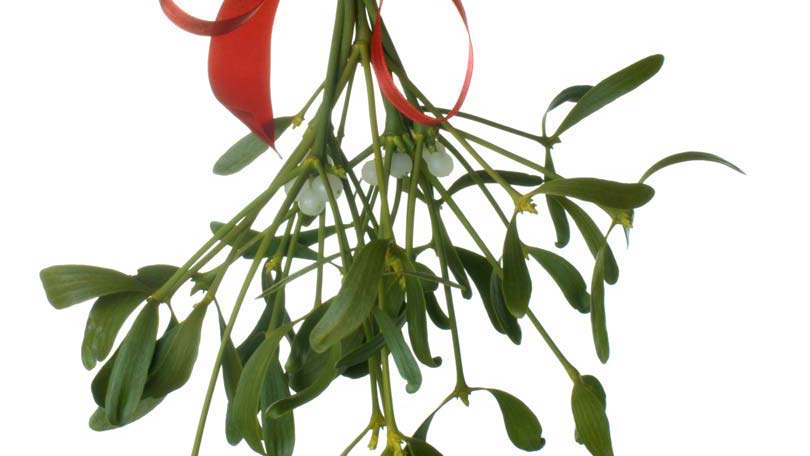
We all know what mistletoe is. It’s that sprig of fauna that people hang in conspicuous places that we hope to avoid so that Uncle Ernie doesn’t do that hearty laugh when he asks where his smooch is. It’s a long held tradition that people either love or hate, hope to be caught under or hope to avoid, and either hang with enthusiasm or refuse to have in their homes.
But what is mistletoe? Why do we insist on hanging it up in doorways and where does it come from? Mistletoe is actually a variety of plants, not just a single plant, and thus any of the varieties can be used. It is also considered a parasitic plant, growing from the nutrients of other plants, usually trees, and sapping their host of their own nutrients which often results in the death of the host plant. It has the capability to grow on its own, but being the sort of lazy plant that it is, mistletoe generally prefers to take from a host plant.
There numerous varieties of mistletoe, most of which grown in the United States anywhere from Florida all the way up the coastline to New Jersey. The type of mistletoes that people use for decoration and kissing at Christmastime is hybrid of the American and European variety.
Mistletoe is very popular in European countries as a treatment for circulatory issues and respiratory problems as well as an intrinsic part of cancer treatment. The United States does not permit the treatment of illness and disease with mistletoe, though other countries have used it with great success.
Celtic and Druid mythology had once thought mistletoe was an adequate antidote to poisons, although several forms of mistletoe berries have proven poisonous. The knowledge that the Druids had in the use of this plant died off thousands of years ago, and now mistletoe is simply considered a plant with poisonous berries.
While Romanians declare mistletoe as a source of good fortune and prosperity, most English speaking countries revere mistletoe for its indication of virility. Throughout European countries and the United States, the obligatory kiss stems from the belief that mistletoe can increase virility and fertility. Of course, we don’t hold this as truth anymore. We rely on pharmaceuticals for such things these days, but there is still just enough superstition to the myth that many families hang the mistletoe from various doorways and archways enticing the obligatory kiss.
Like the holly bush, mistletoe is a winter bearing fruit, adding proof to its legend of virility and fertility enhancing powers. Most mistletoe actually bears its fruit right around the winter solstice, and the fruit’s inner contents even resemble the look of semen. When Paganism created much of the basic natural belief system, this concept added fuel to the notion that mistletoe was capable of enhancing the sexual prowess of men and the reproductive power of women, thus becoming a remarkably important Pagan symbol.
Some cultures, such as Norwegian and Scandinavian histories, couples took fruit from the plant into their bed as a hopeful sign of being blessed with child during sexual intercourse. The plant was considered to lose its virility when the last fruit was plucked, and lovemaking ceased until the plant was replaced with ample fruit to pick from. In accordance with such traditions, mistletoe is considered a “soul” plant, perpetuating that the “soul” of the plant has the power to encourage love, lust, and fertility. It is also considered to rob from the “soul” of its host plant or tree, especially the oak tree.
This powerful and magical plant can be used to ward off spirits of the evil as well as keep witches at bay when hung in the doorways. Generally speaking, the “soul” pf mistletoe is so unique and positive in its power, there are unlimited uses for bringing about positive wonderment through the use of this gregarious plant.
A kiss under the mistletoe, which is now considered a polite and fun Christmas tradition, most likely originates from the custom of initiating marital bliss. Used originally in Greek festivals, particularly the festival of Saturnalia, it was later implemented as rite of passage into the newlywed tradition. Naturally, this arose from a time when marriage could only be blessed with the arrival of numerous children.
The Scandinavians regard mistletoe as a plant of peace. Many truces have been called under the plant’s power, between countries as well as between spouses and loved ones. The arrival of mistletoe during an argument called for an immediate truce and the chance to kiss and make up.
English tradition plays a much heavier association with the power of mistletoe. A young woman who stands under the mistletoe and is not granted a kiss by any passers by can expect not to marry throughout the year. Likewise, the twelfth night of Christmas in English tradition calls for the burning of the Christmas mistletoe to ensure that the young men and women who snuck in a kiss under the magical can never marry each other, as it is improper to kiss someone whom you have no intention of marrying.
The French rely on the mistletoe for the New Year, rather than at Christmastime. To the French, mistletoe for the New Year will bring good luck, prosperity, and of course, procreation.
Despite the enjoyable “powers” that mistletoe possesses, it is commonly used today as fun decoration the inspires Christmas cheer as well as encourages affection between people during the blessed holiday season.
